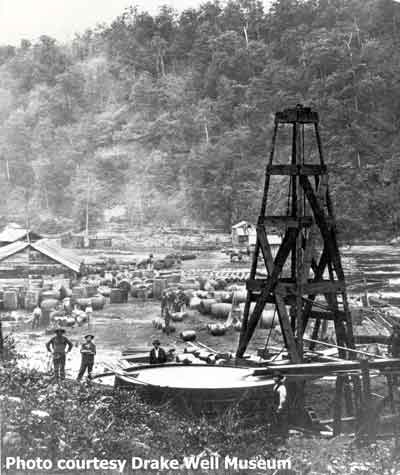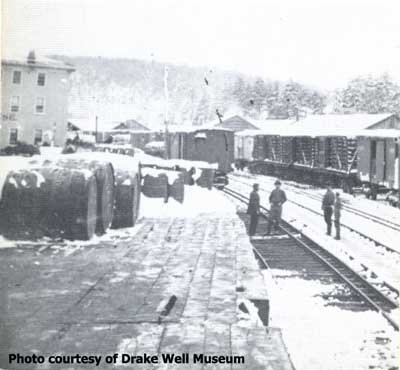 |
||||||
Standardization
Before becoming a container for petroleum, the 42 gallon wooden barrel was in use for wine, beer, whiskey and fish. However, there was considerable irregularity in the capacity of an oil barrel until the volume was settled at 42 gallons. In the 1860's the oil barrels ranged generally from 40 to 50 gallons with volumes often specified at the well or by shippers and carriers at 40, 42, 43, 45 and 46 gallons.
In the early 1860's it was not uncommon to see occasional barrel-like vessels sitting alongside the stacks of regular oil barrels on the loading platforms. Some of these containers were almost one and one-half to double the size of ordinary barrels. A few outlandish ones looked like stock tanks. By the same token, small kegs or casks might be present also.
With the advent of pipelines in the middle and late 1860's and also the use of gathering lines, tanks, bulk boats and railway tank cars, a great deal of oil never was in a barrel, but was nevertheless gauged according to the concepts of the volume of a barrel as seen variously by the producer, shipper and carrier. Standardization did not come from one day to the next. In fact, it wasn't until the early 1870's that the 42 gallon oil barrel became more or less universal.
 |
Wooden barrels and tanks at Tarr Farm, 1862. A few oversize and undersize barrels can be seen under close scrutiny. Oil Creek and flat boats are at the right of the derrick. The well is the Phillips No. 2. |
The first direct move to determining a practical standard for an oil barrel happened in late August, 1866. The Weekly Register, an Oil City newspaper, reported in its August 31 issue that "the oil producers have issued the following circular:"
"Whereas, It is conceded by all producers of crude petroleum on Oil Creek that the present system of selling crude oil by the barrel, without regard to the size, is injurious to the oil trade, alike to the buyer and seller, as buyers, with an ordinary sized barrel cannot compete with those with large ones. We, therefore, mutually agree and bind ourselves that from this date we will sell no crude by the barrel or package, but by the gallon only. An allowance of two gallons will be made on the gauge of each and every 40 gallons in favor of the buyer."
Dr. M.C. Egbert, a well known oilman in Oil Creek Valley, headed the group of thirty or more oil producers who created and endorsed this proclamation. It promoted and established the 42 gallon oil barrel which in 1872 was finally adopted by the Petroleum Producers Association. Peckham, in his 1880 report to the Census Bureau, used the 42 gallon barrel in his compilations and this passed on to the U.S. Geological Survey (1882), U.S. Bureau of Mines and other agencies unto today.
To more fully express the oil barrel as a unit of measurement, it can be defined as 42 U.S. gallons of 231 cubic inches. Qualifying the barrel as a unit becomes even more complex when corrections of the oil for temperature (corrected to 60 degrees F), specific gravity, basic sediment and water (BS&W), locus of measurement (rock reservoir at depth or stock tank at surface) are figured in. Oil shrinks and expands according to pressure and temperature and contains impurities (BS&W) which are calculated. All of these things (and more) have to be taken into account in order that a barrel of crude petroleum serves as a unit of measurement in each circumstance.
A caution is deserved here because a liquid barrel in the U.S. is defined as 31 1/2 gallons. Hardwicke (1958) points out that Texas had (maybe still does) a 31 1/2 gallon definition for a barrel of any liquid including oil. This weights and measures' statute therefore forces the parties to specify 42 gallons as being a barrel in any bulk oil barrel deal. If not specified in the contract, the barrel of oil will be judged to be 31 1/2 gallons by the State and in the courts. This is one state's difference between common usage (42 gallons) and that stated in a statute.
Great Britain uses the cubic meter measurement for oil instead of barrels. A cubic meter of oil is about 6.2897 barrels of 42 U.S. gallons. Another weight or measurement that is sometimes used for oil is the tonne which is equivalent to a metric ton or 1.1 short tons. An imperial gallon (Great Britain, Canada etc.) is 1.2 gallons U.S.
 |
Oversize oil "barrels" at the freight depot in Titusville, ca. 1865. Also shown are two flat cars fitted with two (ea.) 40 barrel (capacity) wooden tanks for bulk transport. These are the Densmore tank cars which were the first railroad tank cars made in America. |
![]()
| © 2004, Samuel T. Pees all rights reserved |
|